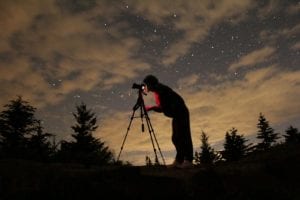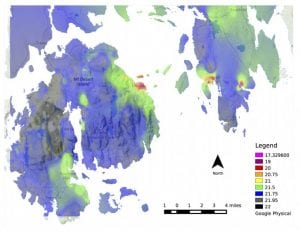Dark Sky
 Gazing at the night sky in any downtown urban area, you will find it difficult to see the Big Dipper or pinpoint the North Star. It is not widely recognized how much light pollution affects the visibility of the night sky around the world. The International Dark Sky Association has undertaken the task of raising awareness of light pollution and promoting the conservation of dark skies throughout the world (International Dark-Sky Association, 2016a). Currently, Acadia National Park is ready to submit a provisional application to become an International Dark Sky Park. The provisional application means that Acadia is not fully compliant with the requirements for a full certification but the provisional certification shows that Acadia is determined to become dark sky certified and preserve the natural beauty of the night sky.
Gazing at the night sky in any downtown urban area, you will find it difficult to see the Big Dipper or pinpoint the North Star. It is not widely recognized how much light pollution affects the visibility of the night sky around the world. The International Dark Sky Association has undertaken the task of raising awareness of light pollution and promoting the conservation of dark skies throughout the world (International Dark-Sky Association, 2016a). Currently, Acadia National Park is ready to submit a provisional application to become an International Dark Sky Park. The provisional application means that Acadia is not fully compliant with the requirements for a full certification but the provisional certification shows that Acadia is determined to become dark sky certified and preserve the natural beauty of the night sky.
Light pollution is commonly defined as the scattering of light in the atmosphere from human sources. As an area populated by humans uses more artificial lighting the amount of measurable light pollution goes up. The most visible and direct effect on light pollution is Sky Glow. Sky glow is a visible brightening of the sky near cities and towns. From a distance sky glow can be seen as a bubble or arcing line across the horizon that seems to be radiating from the town or city of origin. Light pollution can be more personally defined as how much light an individual is projecting into the night sky.
 Among the many aspects of natural beauty in Acadia National Park is the view of the starry night sky. The natural night sky is an integral part of the Park, an element of cultural heritage, and a source of inspiration for visitors. National Park Service (NPS) Management Policies 2006 states that the NPS will “preserve, to the greatest extent possible, the natural lightscapes of parks, which are natural resources and values that exist in the absence of human-caused light.” In addition, “To prevent the loss of dark conditions and of natural night skies, the Service will minimize light that emanates from park facilities, and also seek the cooperation of park visitors, neighbors, and local government agencies to prevent or minimize the intrusion of artificial light into the night scene of the ecosystems of parks.”
Among the many aspects of natural beauty in Acadia National Park is the view of the starry night sky. The natural night sky is an integral part of the Park, an element of cultural heritage, and a source of inspiration for visitors. National Park Service (NPS) Management Policies 2006 states that the NPS will “preserve, to the greatest extent possible, the natural lightscapes of parks, which are natural resources and values that exist in the absence of human-caused light.” In addition, “To prevent the loss of dark conditions and of natural night skies, the Service will minimize light that emanates from park facilities, and also seek the cooperation of park visitors, neighbors, and local government agencies to prevent or minimize the intrusion of artificial light into the night scene of the ecosystems of parks.”


